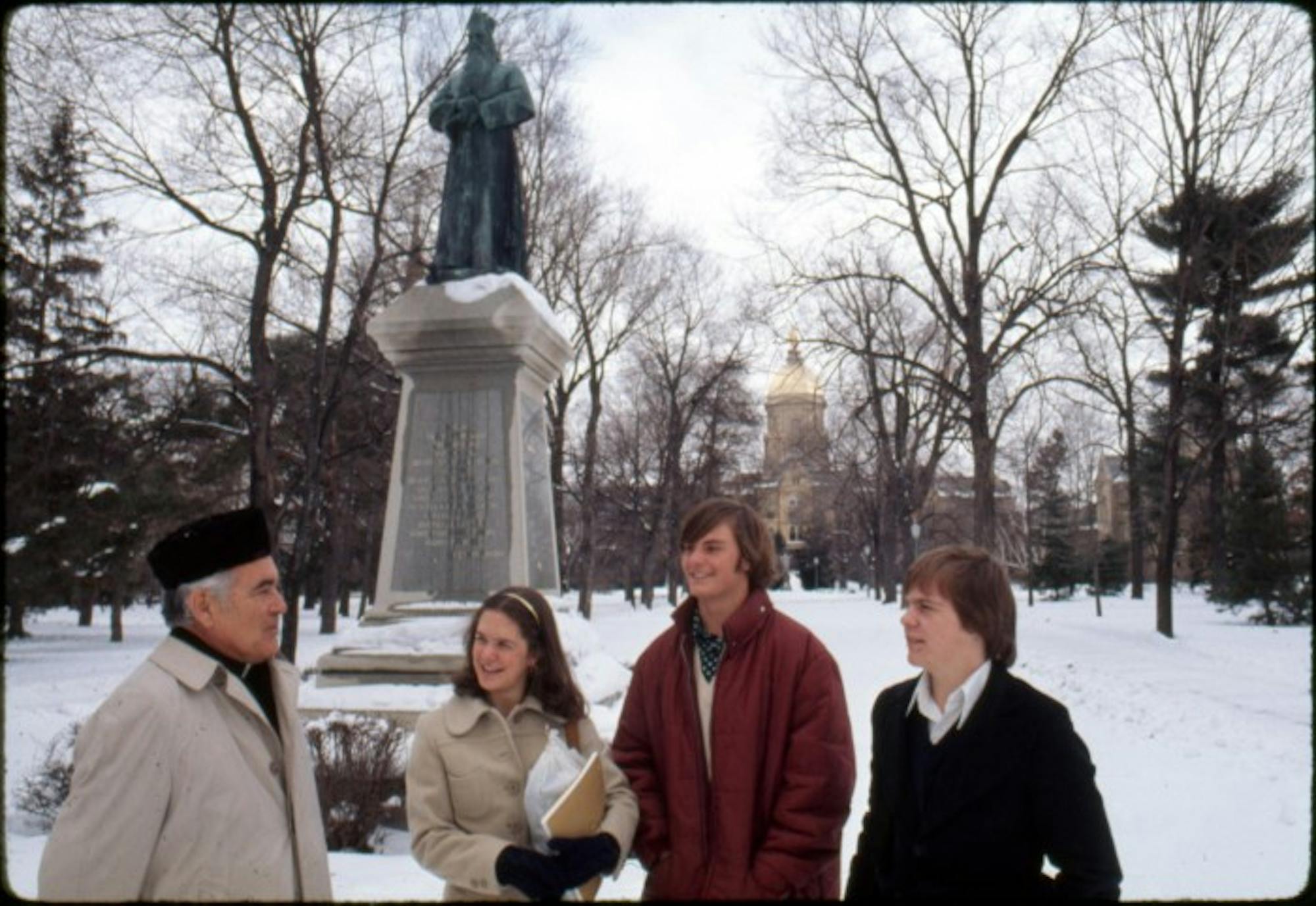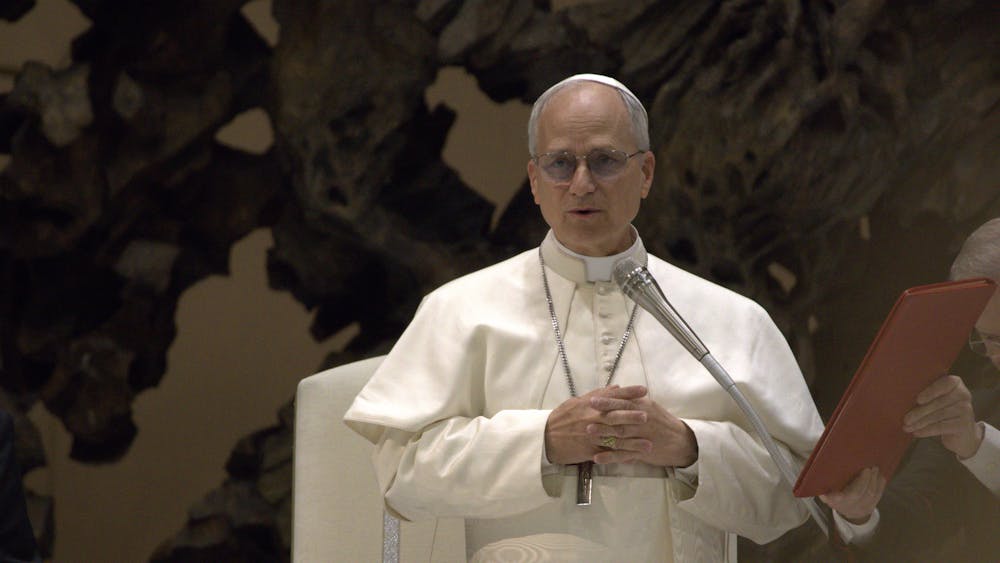Long heralded as the driving force behind coeducation at Notre Dame, University President Emeritus Fr. Theodore "Ted" Hesburgh said he had simple reasons for opening the University to undergraduate women in 1972.
“When God made the human race, he didn’t just make men; he made men and women,” Hesburgh told The Observer in February 2013. “Since this is considered the best Catholic university in the world ever, well, why shouldn’t half the people here be women as well as men, since women … are just as important in the scheme of things?”
To Hesburgh, this logic was obvious. But to many Notre Dame supporters in the early 1970s, the idea was “heresy,” he said.
“They said, ‘You’re giving away the store. This is the greatest macho, male-dominated thing. … The place will go soft. It won’t amount to anything anymore,’” Hesburgh said. “I said, ‘Look, I’m in charge, and this is what I think is important. If we’re going to be the greatest Catholic university, we should be open to women, as well as to men.’”
Although Hesburgh did not face overt opposition to the proposed inclusion of women, instituting coeducation required extensive discussion and personal initiative.
“People didn’t come out with battle axes trying to shut the place down or something. … Like anything else that goes on in a university, [coeducation] got thoroughly discussed, and there were pros and cons, but someone had to make the decision,” he said. “I figured I was the president, so I made the decision that, No. 1, we were going to be coeducational and, No. 2, women were going to have the same … profile of excellence as the male students.”
Hesburgh also thought women deserved access to personal space in dormitories separate from male students. He believed women didn’t need “men looking over their shoulders every hour of the day or night” and, after a certain time in the evening, should have areas all their own.
Hesburgh spent 35 years in the Office of the President, leading Notre Dame from 1952 to 1987. In that time, he doubled the University’s enrollment, grew its endowment, added 40 new buildings, increased student aid and added lay people to the Board of Trustees. But he said he considered instituting coeducation to be the best decision he made while at the University’s helm.
“I moved ahead quickly, and I’ve never regretted it,” he said. “I think women are holding their own here and putting together a very good record, of which I’m very proud.”
‘Impossible conditions’
Although Hesburgh’s personal convictions about the role of women in University life largely propelled the transition to coeducation, the final decision came after discussions in 1971 with Saint Mary’s College about a potential merger between the schools.For about six years, Notre Dame and Saint Mary’s had operated a co-exchange program in which students at one institution could take classes at the other. This arrangement brought undergraduate women to Notre Dame’s campus, where a few female students already were enrolled in graduate programs.
Then, departments at the two institutions started to work together more closely, and some almost merged. Meanwhile, many Saint Mary’s women became cheerleaders for Notre Dame sports teams, former Vice President for Student Affairs Fr. Tom Blantz told The Observer in November 2013.
Blantz, who stepped into that position in 1971, was among the administrators who determined the University would directly admit women to its undergraduate student body following failed discussions to combine Notre Dame and Saint Mary’s. For a while, however, it looked as if administrators from both schools would approve the merger.
“There was a lot of closer relationships in different areas of the University,” Blantz said. “Then [administrators] started to investigate the idea of just merging and making one big university. It looked like it was going that direction anyway if each department was going to start merging.”
Additionally, Blantz said, University administrators thought admitting undergraduate women to Notre Dame would raise the level of academics, teach men to work with women, make the school more attractive to prospective male applicants and support Catholic education for young women.
“Those were some of the reasons that I think Fr. Hesburgh and others decided that it’s time for men and women to be educated together,” Blantz said. “And a logical thing to do would be to merge with Saint Mary’s. They had a very good college over there, and we had a very good college over here, and rather than starting from scratch some place, and especially with the co-exchange program going so well, that seemed to be the logical thing to do.”
But administrators struggled to determine how to keep the College’s name alive. Furthermore, operating one combined school seemed like it would cost, rather than save, money.
“Ted emphasizes that there was just a different view of what the final institution would look like,” Blantz said.
Ultimately, “impossible conditions” prevented Notre Dame from agreeing to merge with Saint Mary’s, Hesburgh said.
“After two or three of these forays … I said, ‘Well, why don’t we just say it’s been an interesting discussion. We’re still open to merge with Saint Mary’s at any time. If you want to reopen the discussion, that’s fine, but there’s no point getting into a discussion where one side has a strong power blocking every time we get close to a merger,’” he said.
‘The best of all worlds’
Administrators at Notre Dame and Saint Mary’s officially announced the cancellation of the merger in November 1971. Shortly thereafter, then-Associate Provost Fr. Ferdinand Brown called Blantz to tell him Notre Dame would admit 325 undergraduate women — 125 first-years and 200 transfers — for the next academic year.“Many of those transfer women obviously would be from Saint Mary’s,” Blantz said. “I think we probably felt that since the two schools had jointly announced that we were merging, that if then there were some women that enrolled at Saint Mary’s for programs that Saint Mary’s did not have, because we told them we were going to be one school … Notre Dame probably felt some obligation if those students wanted to transfer over here, that we should let them transfer.”
As a first-year law student in 1970, Kathleen Cekanski-Farrand was one of 12 women out of 250 students in her class, part of only the third coeducational graduate class in the Law School. Two years later, she was mailing letters to welcome 119 women of the first female undergraduate class into her care as rector of Badin Hall.
Hesburgh gave the women of Badin their first mascot — a small Snoopy statue that represented the dorm for years. He judged a door-decorating competition at Christmastime and often called Cekanski-Farrand to make sure everything in the women’s hall was running smoothly.
He shared her commitment, she said, to integrating women into the student body and bringing Notre Dame to the place it is today.
“[Hesburgh] took the time to do that,” she said. “I couldn’t have asked for a more gracious individual who was wanting to make this a positive for the University.”
In February 2013, more than 40 years after the proposed merger failed, Hesburgh said his feelings about it had not changed. He was happy to see women succeed as Notre Dame students and to witness growth in the relationship between Notre Dame and Saint Mary’s.
“I was in favor of the merger, and I think the superior general [at Saint Mary's] was in favor of the merger. … To this day, I favor joining, but I don’t think it’s necessary,” he said. “I think we’ve become closer to [Saint Mary's] in many ways. … I think we have the best of all worlds short of a merger, so I’ve been happy to see that develop.”
Hesburgh said the mutually beneficial relationship between the schools is due in part to their shared history, beginning when Fr. Edward Sorin founded Notre Dame in 1842 and the Sisters of the Holy Cross followed suit and opened Saint Mary's in 1844.
“I think it’s interesting that when Sorin began the school in those days, there were no [coeducational] schools,” Hesburgh said. “[Notre Dame] became a men’s school, but only a year or so went by before [Sorin] asked the sisters to start a school on the other side of the road. Our history is almost identical, … and from [the 1840s] on, we’ve been close together and should be. [Saint Mary's] has been helpful to us and vice versa.”
‘A more normal human situation’
In the decades following women’s admittance to Notre Dame, Hesburgh saw their successors make significant contributions to the University’s intellectual, athletic and religious life, complementing the work of their male counterparts.“Women more and more have had their say on campus. … Men and women tend to think very much along the same lines at a Catholic university,” he said. “I’d have to work hard to scrape up a problem [between men and women]. … I think we get along as a happy family where we’re both making good contributions to the good of the whole enterprise.”
Hesburgh said he thought the inclusion of women made the University a microcosm more representative of the world in general. It became, he said, “a much more normal human situation.”
Indeed, the world outside Notre Dame had a major impact on coeducation and the University as a whole, especially in the midst of the Vietnam War, the civil rights movement and other political turmoil at home and abroad.
“The great national decisions that were going on … all of these things that affected the world were bound to affect the University,” he said. “I was very happy that the students were very active in world affairs and came at them from different points of view as men and women.”
Though the political and social climate outside the University has changed considerably since 1972, Hesburgh said such a dynamic environment encourages Notre Dame students to consider their role in the world after graduation.
“I think [involvement in world affairs] was a good thing for education at Notre Dame because we don’t want to be in another world,” he said. “We want to be in the world that exists right now. We want to compete in that world, and we want to be leaders in that world, and that’s true of both men and women.”
Former News Editor Kristen Durbin, class of 2013, and former Managing Editor Megan Doyle, class of 2013, contributed to this story.









